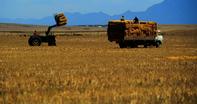Enough Food for the World
For so long, the story of food security has started in the ploughed fields of farms the world over. The issue has been seen as simply that, about food production, good old-fashioned agriculture. Are we growing enough food to satisfy the world’s increasing appetite?

And the conversation seldom goes beyond that. So governments hand their food security strategies over to their respective agriculture departments. Or aid money goes into getting fertiliser to subsistence farmers in developing countries. Or a city’s entire food security budget gets poured into buying seedlings, spades and irrigation pipes so that poor people can grow their own vegetables.
Invariably, when the conversation on food security starts, it centres on whether large-scale farmers are commercially viable, or whether emerging and subsistence farmers are getting the right kind of information handed to them by extension officers, or it wonders why food gardens in cities are failing. And this is where it stops. But this clearly is not the whole story.
The United Nations Food and Agriculture Organization (FAO) said in 1996 that we were producing enough food globally to provide everyone – 6 billion or so – 2 700 calories each day.
Not too much has changed since then. There are a few more of us around now – 7 billion and counting – and we are still producing masses of food, in spite of climatic shifts and peak oil threatening to pinch off the vital arteries that feed parts of the agriculture model. And yet, in spite of this, a billion people live in hunger around the world; a billion are malnourished; and, bizarrely, a billion are overweight, while half of these are obese, according to the Worldwatch Institute.
Farming - A Small Part of the Chain
If you think of the journey that food travels to get from field to fork, the farming side is just one small part of a massive, industrial-scale food value chain. There are forces exerting themselves throughout this system that determine whether or not housewives on the receiving end (yes, it is still largely women who are responsible for the household’s food spend) are able to get the right kind of good, healthy food for their families.
For the United Nations, food security occurs when ‘all people, at all times, have physical, social and economic access to sufficient, safe and nutritious food that meets their dietary needs and food preferences for an active and healthy life’. Clearly, whether or not a farmer is harvesting enough beetroot or maize each season is just a small part of this.
Food security, really, is about hunger. It is about those who live with it and those who do not, and why. It is about the threat of hunger; it is about living in fear of hunger; the stunted development that comes from prolonged hunger; the ill health that is a consequence of hunger; the food choices we make in order to avoid hunger; the environmental and political and economic fallout of hunger; how the geography of our cities makes us hungry.
The Cost of Undernutrition

The cumulative effect of malnutrition like this can cost a developing country 6–12% of the gross national product, the World Bank estimates. As for the individual, someone could experience ‘productivity losses’ amounting to more than 10% of his or her potential lifetime earnings. ‘If a figure of a 6% loss were applicable to South Africa, the cost of undernutrition alone could amount to at least four billion rand.
If the cost of the chronically and acutely ill patients who are under-nourished is taken into account, the loss could be far higher,’ says the South African Department of Health and UNICEF. In a 2004 World Bank and UNICEF calculation, South Africa’s gross domestic product (GDP) losses were estimated to be around R7.1 billion annually due to vitamin and mineral deficiencies, and yet this kind of malnutrition can be dealt with effectively simply by injecting R325 million per year into targeted micronutrient interventions.
The figures for Africa as a whole, for both the human and the financial cost of malnutrition, are similarly dramatic. It drains 3% off the GDP of African economies, it kills 3.5 million children annually and contributes to more than a third of deaths of children under the age of five, says the Global Alliance for Improved Nutrition (GAIN).
Speaking from the Washington office of GAIN, senior adviser Kari Stoever reiterates this, saying just how much malnutrition is an impediment to productivity, economic growth and poverty reduction.
Malnutrition Slows Economic Growth
‘The World Bank has identified three routes through which malnutrition slows economic growth and perpetuates poverty,’ says Kari Stoever, ‘through direct loss in productivity from poor physical status, through the indirect loss in productivity from poor cognitive development and deficits in schooling, and due to losses in financial and other resources from increased healthcare costs of ill health.’
Stoever maintains that if it is not reduced significantly, nutritional deficiencies could cost the global economy about US$180–250 billion over the next ten years. ‘And yet total public investments to address these deficiencies are estimated to be in the order of only US$4–5 billion,’ she says. Alarmingly, malnutrition is on the rise in sub-Saharan Africa.
And in South Africa, the rate of urbanisation means slow growth and development seen in children is becoming more and more evident in the cities, where the urban poor struggle to eke out a living on the margins of the economy, often living in squalid conditions. Similar trends might well be found in the SADC region.
By Leonie Joubert